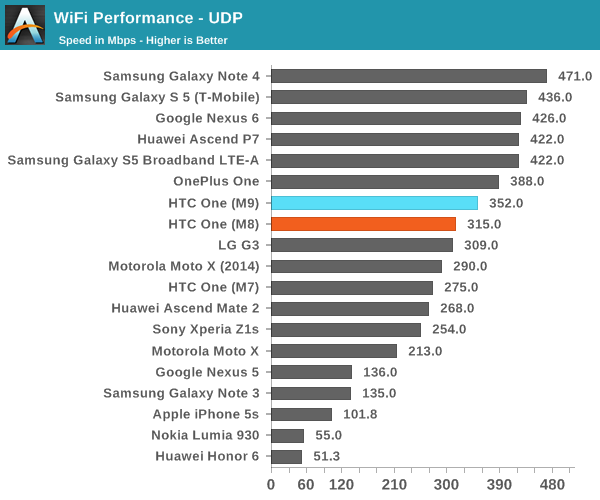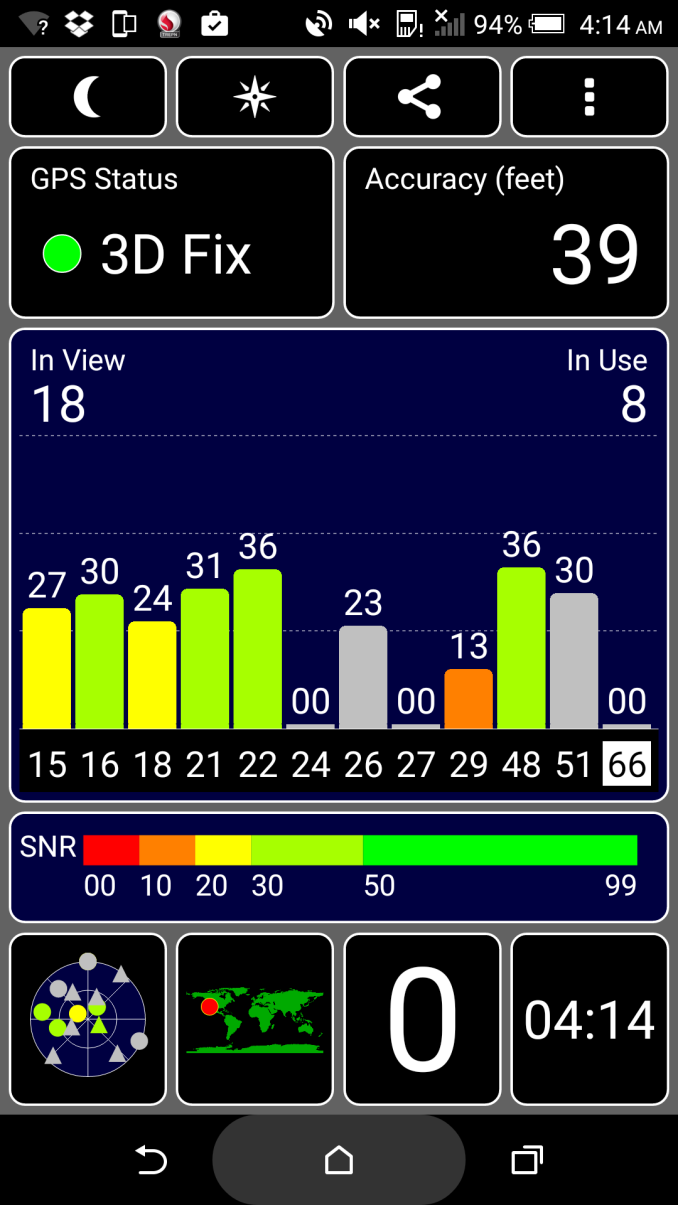The HTC One M9 Review: Part 2
by Joshua Ho on April 6, 2015 10:00 AM EST- Posted in
- Smartphones
- HTC
- Qualcomm
- Mobile
- Snapdragon 810
- One M9
WiFi Performance
Fundamentally, a smartphone is defined by its ability to connect to the internet. Although cellular data is important, WiFi performance is crucial for anyone on a limited data plan and in areas where cellular data is slow or nonexistent. To this end, HTC has outfitted the One M9 with Broadcom’s BCM4356 WiFi/BT combo chipset, which we’ve seen before in the Nexus 6. This chipset supports 2x2 802.11ac, but the One M9 only supports a maximum 433 Mbps physical link rate, which means that it’s only using a single spatial stream. I haven’t been able to find any information on the antenna configuration of the One M9, but it’s likely that HTC is only using a single antenna for WiFi on the One M9 which would make it similar to the One M7 and One M8 in that regard. In order to test how this configuration performs, we use IPerf on Android connected to a PC to see how rapidly the device can send UDP packets.

As one can see, there’s a reasonable performance uplift when compared to Qualcomm Atheros’ WCN3680 WiFi/BT combo chip, but it isn’t as big as moving to a 2x2 MIMO configuration. The lack of MIMO also has implications for WiFi range, but WiFi signals degrade quickly enough that this wouldn’t be a massive difference.
GNSS
As the One M9 uses a Qualcomm modem, it's a pretty safe bet that it also uses the modem for GNSS location services. In practice, this means that the One M9 locks on to satellites quickly any time it's possible to download assistance data to speed up GPS.
Without assistance data, the One M9 seems to have worse performance than expected, although weather conditions can always affect overall performance. Time to first lock took a minute and 42 seconds, and accuracy wasn't quite as high as one would hope, tending towards 30 foot accuracy rather than 10 foot accuracy. It's likely that local weather conditions were responsible for this issue, as subjectively it seemed that GPS performance was comparable to other phones tested at the same time.











127 Comments
View All Comments
nismotigerwvu - Monday, April 6, 2015 - link
This is quite sad really. Both the HTC devices I've owned (going way back for the 1st with a Windows Mobile 6 packing Mogul/Titan and more recently the OG Evo) have been fantastic pieces of hardware. Perhaps some continued firmware tweaks can bring the camera performance back around, but the SoC really seems to be dragging the model down. Maybe even a midcycle refresh, like and M8+ with a better suited SoC. I haven't looked into it in awhile, but at least a few months ago there were rumors floating around of a new model that massaged the power usage a bit, I think it was being referred to as an 815 but this is purely off memory.DanNeely - Monday, April 6, 2015 - link
Qualcomm is denying that there was ever such a thing as an 815 on their roadmap; and is putting the 820 on the roadmap for retail availability at the end of this/start of next year.http://www.fudzilla.com/news/mobile/37406-there-is...
Laxaa - Monday, April 6, 2015 - link
I really wonder how the rest of this years Snapdragon 810 devices will perform. The LG G4 is even rumored to be using the 808 instead, due to the issues with the G Flex 2.jjj - Monday, April 6, 2015 - link
It's all good, Qualcomm will provide free cases with 60mm USB powered fans for every phone with Snapdragon810.As an alternative they'll also sell phase-change cooling backpacks.
Frenetic Pony - Monday, April 6, 2015 - link
A large part is the Cortex a57 and a53 cores. By all the looks of it Qualcomm could, and should, have stuck with their increasingly aging Snapdragon cores, shrunk the process to TSMC or Samsung's 20nm, and gottent better perf/battery life out it.blanarahul - Monday, April 6, 2015 - link
While it is true that the S810 would have been better with Krait, you have to consider the fact that ARM had already optimized the A57 and A53 cores for 20 nm and Qualcomm would have had to spend additional resources to get Krait to work well on 20 nm which would:-a) Ended up delaying Krait's ARMv8 successor.
b) Not be as efficient because a lot of improvements in Krait 400/300 came from the fact that 28 nm was a mature process and Qualcomm was used to it.
blanarahul - Monday, April 6, 2015 - link
You have to blame HTC to really. They should have compensated for S810 by including panel self refresh and a bigger battery but noooo, they want to make the phone as cheap as possible (display isn't well calibrated remember) and sell well for 700$. Sorry HTC, you aren't getting much money this year.Gunbuster - Tuesday, April 7, 2015 - link
but but but R&D costs money, blah blah blah...Nope they slap the same commodity SOC, screen, battery, and camera together just like everyone else these days. The $600+ phone gravy train is running off the tracks.
skavi - Wednesday, April 8, 2015 - link
They did add a larger battery.TylerGrunter - Tuesday, April 7, 2015 - link
The Krait cores were only competitive against A15 cores due to their ability to run at higher frequency. The issue with that is that 20nm in TSM they only had LPE, which seems to be terrible at high frequency, so they needed to use cores with higher IPC or there would be a huge performance regression and a terrible comparison with A57 cores.